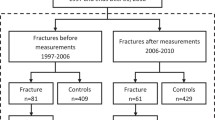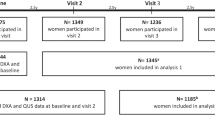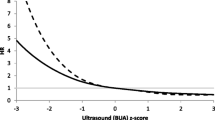Abstract
We studied 336 elderly white women, of whom 22 had previously suffered a hip fracture and 22 had previously suffered a vertebral fracture. All subjects were 60 years old or older with a mean age of 73.7 years. Measurements of ultrasonic transmission velocity (UTV), broad-band ultrasonic attenuation (BUA) and stiffness (STF) were made at the os calcis using a Lunar Achilles ultrasound device. Measurements of lumbar spine bone mineral density (L2–4 BMD) and femoral neck BMD were made using dual-energy X-ray absorptiometry. The fracture groups were significantly older and had more years since menopause than the control groups. Logistic regression showed that measurements of UTV, STF and BUA discriminated between fracture and non-fracture subjects for both the hip (p<0.001) and spine (p<0.05). Femoral neck BMD discriminated both hip and vertebral fractures from controls (p<0.001 andp<0.01, respectively). Spinal BMD discriminated between subjects with vertebral fractures and those without (p<0.01), but not hip fractures (p=0.64). For hip fracture, areas under receiver-operating characteristic (ROC) curves were 0.85 for UTV, 0.83 for STF, 0.79 for BUA, 0.78 for femoral neck BMD and 0.53 for spinal BMD. For vertebral fracture, areas under the ROC curve were 0.68 for UTV, 0.70 for STF, 0.66 for BUA, 0.66 for femoral neck BMD and 0.67 for spinal BMD. To determine whether calcaneal ultrasonic measurements discriminated, independently of BMD, fracture from control groups, UTV, BUA and STF were adjusted for BMD, age and years since menopause using multiple regression analysis and the residuals from the regressions were incorporated into a logistic regression analysis. Adjusted ultrasonic measurements discriminated hip fracture from control groups (p<0.005 for UTV;p<0.05 for BUA;p<0.01 for STF) but not vertebral fracture (p=0.37 for UTV;p=0.53 for BUA;p=0.25 for STF). These results show that, when ultrasonic measurements were adjusted for BMD and age, they still discriminated between hip fracture and control groups. This finding supports the hypothesis that ultrasonic measurements contain information about bone strength not contained in bone density measurements that may be useful in predicting hip fractures. Therefore, calcaneal ultrasound measurements may provide a safe, low-cost addition to bone densitometry.
Similar content being viewed by others
References
Cummings SR, Black DM, Nevitt MC, et al. Bone density at various sites for prediction of hip fractures. Lancet 1993;341:72–5.
Hui S, Slemenda CW, Johnston CC Jr. Baseline measurement of bone mass predicts fracture in white women. Ann Intern Med 1989;111:355–61.
Melton LJ III, Atkinson EJ, O'Fallon WM, et al. Long-term fracture prediction by bone mineral assessed at different skeletal sites. J Bone Miner Res 1993;8:1227–33.
Ross PD, Genant HK, Davis JW, et al. Predicting vertebral fracture incidence from prevalent fractures and bone density among non-black, osteoporotic women. Osteoporosis Int 1993;3:120–6.
Einhorn TA. Bone strength: the bottom line. Calcif Tissue Int 1992;51:333–9.
Heaney RP, Avioli LV, Chesnut III CH, et al. Osteoporotic bone fragility: detection by ultrasonic transmission velocity. JAMA 1989;261:2986–90.
Porter RW, Miller CG, Grainger D, Palmer SB. Prediction of hip fracture in elderly women: a prospective study. BMJ 1990;301:638–41.
Resch H, Pietschmann P, Bernecker P, et al. Broadband ultrasound attenuation: a new diagnostic method in osteoporosis. AJR 1990;155:825–8.
Agren M, Karellas A, Leahey D, et al. Ultrasound attenuation of the calcaneus: a sensitive and specific discriminator of osteopenia in postmenopausal women. Calcif Tissue Int 1991;48:240–4.
Baran DT, Kelly AM, Karellas A, et al. Ultrasonic attenuation of the os calcis in women with osteoporosis and hip fractures. Calcif Tissue Int 1988;43:138–42.
Langton CM, Palmer SB, Porter RW. The measurement of broadband ultrasonic attenuation in cancellous bone. Eng Med 1984;13:89–91.
Kaufman JJ, Einhorn TA. Perspectives: ultrasonic assessment of bone. J Bone Miner Res 1993;8:517–25.
McKelvie ML, Fordham J, Clifford C, Palmer SB. In vitro comparison of quantitative computed tomography and broadband ultrasonic attenuation of trabecular bone. Bone 1989;10:101–4.
McCloskey EV, Murray SA, Charlesworth D, et al. Assessment of broadband ultrasonic attenuation in the os calcis in vitro. Clin Sci 1990;78:221–5.
Poll V, Cooper C, Cawley MID. Broadband ultrasonic attenuation in the os calcis and single photon absorptiometry in the distal forearm: a comparative study. Clin Phys Physiol Meas 1986;7:375–9.
Hosie CJ, Smith DA, Deacon AD, Langton CM. Comparison of broadband ultrasonic attenuation of the os calcis and quantitative computed tomography of the distal radius. Clin Phys Physiol Meas 1987;7:303–8.
Evans WD, Crawley EO, Compston JE, et al. Broadband ultrasonic attenuation and bone mineral density [letter]. Clin Phys Physiol Meas 1988;9:163–5.
Zagzebski JA, Rossman PJ, Mesina C, et al. Ultrasonic transmission measurements through the os calcis. Calcif Tissue Int 1991;49:107–11.
Ross PD, Davis JW, Epstein RS, Wasnich RD. Pre-existing fractures and bone mass predict vertebral fracture incidence in women. Ann Intern Med 1991;114:919–23.
Hui SL, Slemenda CW, Johnston CC Jr. Age and bone mass as predictors of fracture in a prospective study. J Clin Invest 1988;81:1804–9.
Wasnich RD, Davis JW, Ross PD. Spine fracture risk is predicted by non-spine fractures. Osteoporosis Int 1994;4:1–5.
Burstein AH, Reilly DT, Martens M. Aging of bone tissue: mechanical properties. J Bone Joint Surg [Am] 1976;58:82–6.
Yamada H. Strength of biological materials. Robert E. Krieger, Huntington, 1973.
Atkinson PJ. Changes in resorption spaces in femoral cortical bone with age. J Pathol Bacteriol 1965;89:173–8.
Vogel HG. Influence of maturation and aging on mechanical and biochemical parameters of rat bone. Gerontology 1979;25:16–23.
Hordon LD, Peacock M. Osteomalacia and osteoporosis in femoral neck fracture. Bone Miner 1990;11:247–59.
Turner CH, Eich M. Ultrasonic velocity as a predictor of strength in bovine cancellous bone. Calcif Tissue Int 1991;49:116–9.
Rossman P, Zagzebski J, Mesina C, et al. Comparison of speed of sound and ultrasound attenuation in the os calcis to bone density of the radius, femur, and lumbar spine. Clin Phys Physiol Meas 1989;10:353–60.
Heaney RP. The natural history of vertebral osteoporosis. Is low bone mass an epiphenomenon? Bone 1992;13:S23–6.
Brandenburger G, Waud K, Baran D. Reproducibility of uncorrected velocity of sound does not indicate true precision [abstract]. J Bone Miner Res 1992;7:S184.
Author information
Authors and Affiliations
Rights and permissions
About this article
Cite this article
Turner, C.H., Peacock, M., Timmerman, L. et al. Calcaneal ultrasonic measurements discriminate hip fracture independently of bone mass. Osteoporosis Int 5, 130–135 (1995). https://doi.org/10.1007/BF01623314
Received:
Accepted:
Issue Date:
DOI: https://doi.org/10.1007/BF01623314




